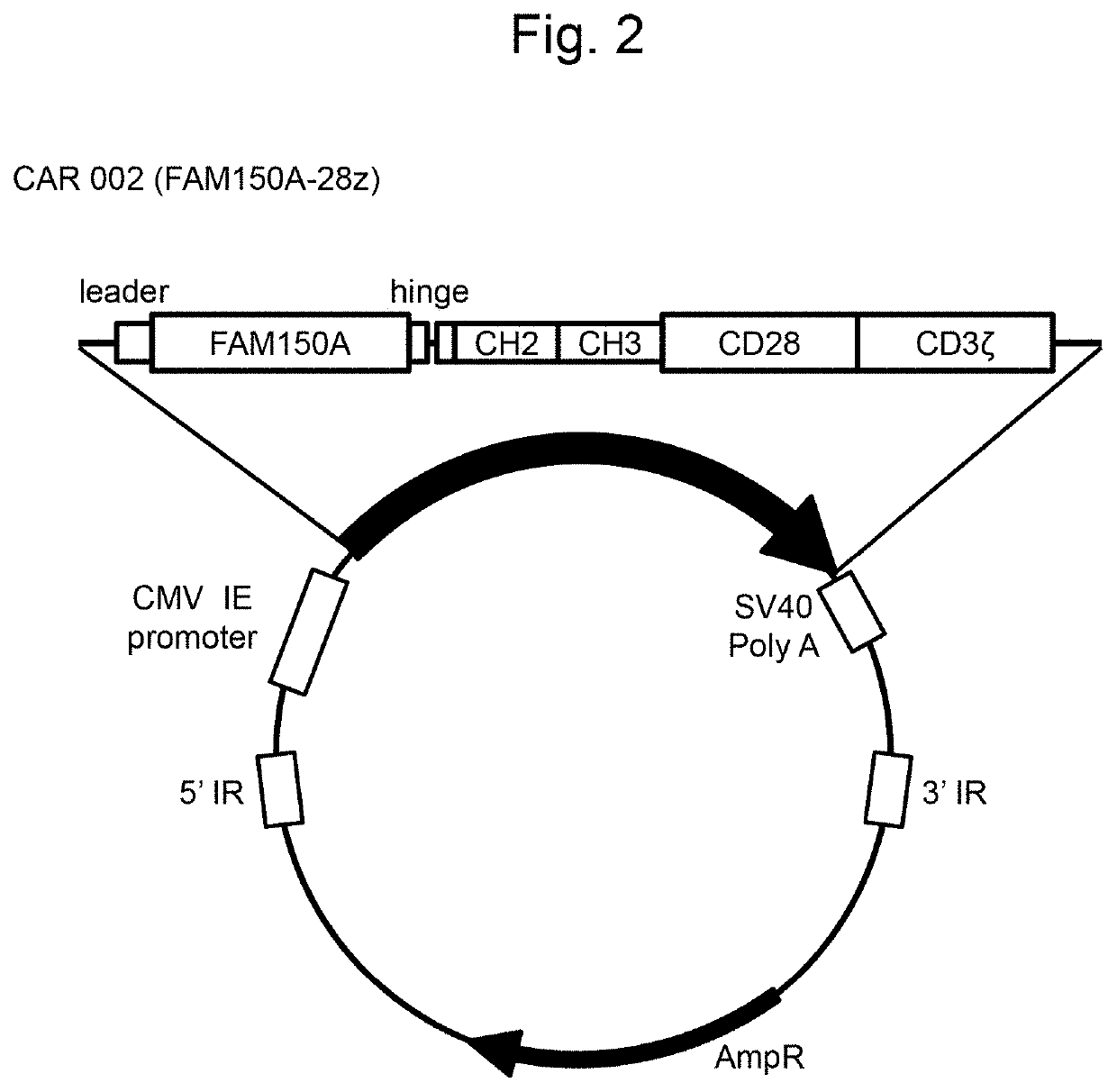Chimeric antigen receptor-expressing cells targeting alk
a technology of chimeric antigen receptor and alk, which is applied in the direction of cell culture active agents, drug compositions, peptides, etc., can solve the problems of ineffective small molecule inhibitory agents, ineffective clinical application of cars, and inability to achieve clinical application
- Summary
- Abstract
- Description
- Claims
- Application Information
AI Technical Summary
Benefits of technology
Problems solved by technology
Method used
Image
Examples
example 1
[0146]Preparation of FAM150A (CAR 002; FAM150A-28z), FAM150B (CAR 003; FAM150B-28z), humanized ALK48 scFv (CAR 004; hALK48-28z), or mouse ALK48 scFv-type (CAR 005: ALK48-28z) CAR-expressing plasmids Artificial synthesis of FAM150A, FAM150B, humanized ALK48 scFv, or mouse ALK48 scFv gene
[0147]In order to prepare a CAR-expressing plasmid of the structure similar to that of the GMR CAR-expressing plasmid described in WO 2018 / 052142 (CAR001, a vector map thereof is shown in FIG. 1), FAM150A, FAM150B, humanized ALK48 scFv, and mouse ALK48 scFv genes to be incorporated into the plasmid were synthesized.
[0148]A DNA sequence (XhoI-leader-FAM150A-Hinge-DraIII; SEQ ID NO: 2) comprising a restriction enzyme XhoI cleavage sequence and a leader sequence added to upstream a translation region (206 to 592 bp; SEQ ID NO: 1) of FAM150A (NCBI Accession Number: NM_207413.3) and a hinge region and a restriction enzyme DraIII cleavage sequence added to downstream thereof was designed. The leader sequenc...
example 2
Culture and Proliferation of CAR-T Cells
[0156]Peripheral blood mononuclear cells (PBMCs) were separated by any of the methods described below.
Day 0: Separation of Peripheral Blood Mononuclear Cells (PBMCs) (Density Gradient Centrifugation)
[0157]Peripheral blood samples were obtained from healthy adult donors and diluted to 2-fold with D-PBS (FUJIFILM Wako Pure Chemical Corporation). The diluted peripheral blood was superposed on Ficoll-Paque PLUS (GE Healthcare), and centrifugation was carried out at 400× g for 30 minutes to fractionate the PBMC layer. The fractionated PBMCs were washed 2 times with D-PBS and isolated via centrifugation.
Day 0: Separation of PBMCs (Separation Using SepMate-50)
[0158]Peripheral blood samples were obtained from healthy adult donors and diluted to 2-fold with D-PBS (FUJIFILM Wako Pure Chemical Corporation). SepMate-50 (STEMCELL Technologies) was filled with 15 ml of Ficoll-Paque PLUS in advance, the diluted peripheral blood samples were superposed thereo...
example 3
[0177]Comparison of Antitumor Activity of FAM150A CD28-Type CAR-T, FAM150B CD28-Type CAR-T, Humanized ALK48 scFv CD28-Type CAR-T, and Mouse ALK48 scFv CD28-Type CAR-T
Measurement of antitumor activity of CAR-T
[0178]In order to measure antitumor activity of CAR-T 002 to CAR-T 005 obtained in Example 2, co-culture with solid tumor cells was conducted. In this example, neuroblastoma cell line SH-SY5Y cells (DS Pharma Biomedical Co., Ltd.), NB-1 cells (JCRB Cell Bank), or IMR-32 cells (DS Pharma Biomedical Co., Ltd.) were used as target tumor cells.
[0179]SH-SY5Y cells, NB-1 cells, and IMR32 cells were subjected to passage culture and used for co-culture test. In passage culture, D-MEM / Ham's F-12 medium containing 15% FBS, 1% penicillin / streptomycin, and 1% non-essential amino acid solution is used for SH-SY5Y cells. RPMI 1640 medium containing 10% FBS and 1% penicillin / streptomycin is used for NB-1 cells, and E-MEM medium containing 10% FBS, 1% penicillin / streptomycin, and 1% non-essenti...
PUM
| Property | Measurement | Unit |
|---|---|---|
| Fraction | aaaaa | aaaaa |
| Composition | aaaaa | aaaaa |
| Therapeutic | aaaaa | aaaaa |
Abstract
Description
Claims
Application Information
 Login to View More
Login to View More - R&D
- Intellectual Property
- Life Sciences
- Materials
- Tech Scout
- Unparalleled Data Quality
- Higher Quality Content
- 60% Fewer Hallucinations
Browse by: Latest US Patents, China's latest patents, Technical Efficacy Thesaurus, Application Domain, Technology Topic, Popular Technical Reports.
© 2025 PatSnap. All rights reserved.Legal|Privacy policy|Modern Slavery Act Transparency Statement|Sitemap|About US| Contact US: help@patsnap.com



